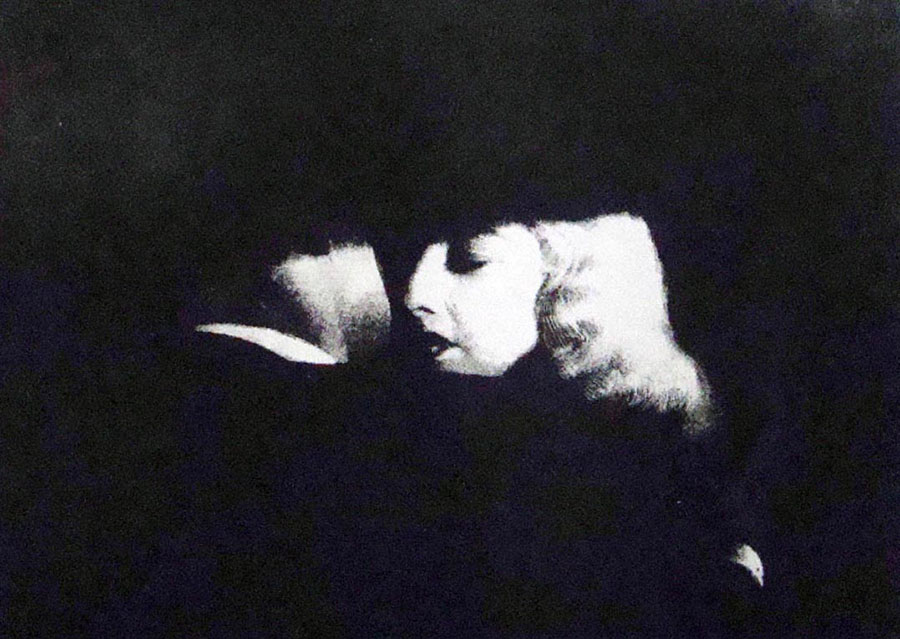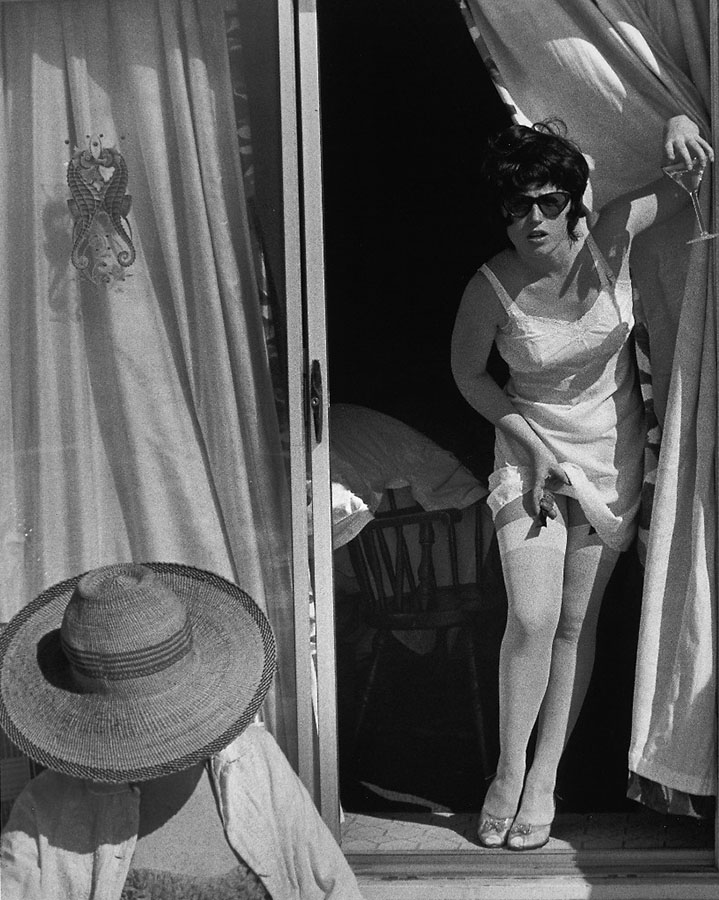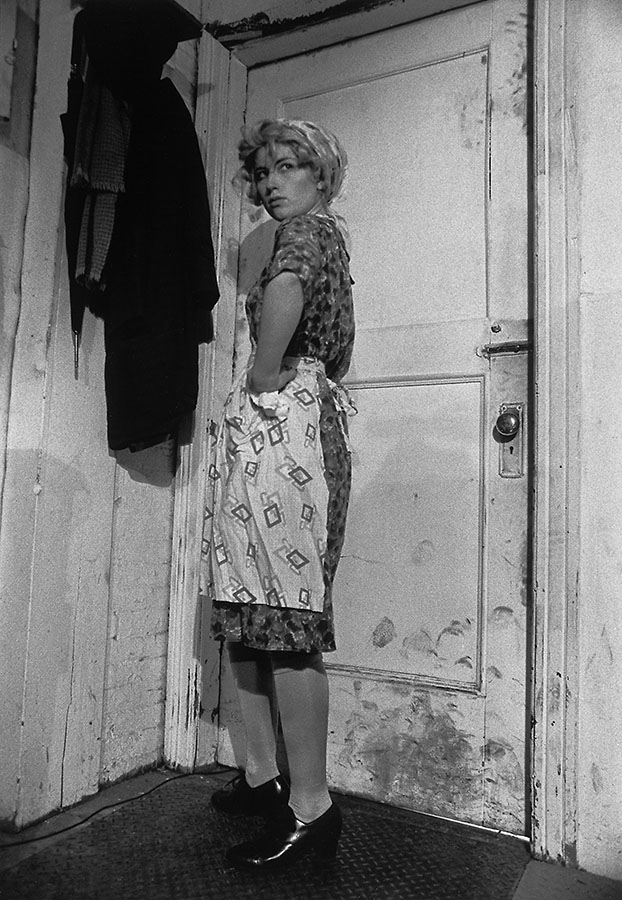Rendezvous In Black:
Cindy Sherman and Ann Chernow

Lithograph on Carson paper, 11 x 14 inches
An opening reception will be held on Thursday, November 10 from 5:30-7pm at the HMA, located at 900 Lafayette Blvd in Bridgeport, CT. Film professor and author Dr. Richard L. Edwards, Ball State University, will give a talk about women and film noir at 6pm.
Cindy Sherman and Ann Chernow draw from the film noir style to create photographs and prints that are contemporary, yet offer moments that could have been documented on the movie sets themselves. Both artists explore the three roles women commonly play in noir films: the good woman, the marrying woman and the femme-fatale. The "stills" are provocative, mysterious and dare the viewer to decide what’s happening in each scene.
About the Exhibition
Cindy Sherman and Ann Chernow draw from the film noir style to create pieces that are contemporary yet offer moments that could have been seen on the movie sets themselves. Both artists mine the noir genre teasing out visual tropes and female roles are explored, and the frames are provocative, mysterious and dare the viewer to decide what’s happening in each scene.”
Cindy Sherman’s series, Untitled Film Stills (1977-1980), re-presented female identity by deconstructing the prevailing visual tropes of femininity. Utilizing the 8 x 10” format of film stills used to promote a Hollywood starlet’s most recent B film, Sherman created numerous female identities. Twelve of the sixty-nine photographs that comprise this series are on view in the exhibition and evoke the three roles women commonly play in noir films: the good woman, the marrying woman and the femme-fatale.
The femme fatale rejects the position of “saintly woman,” as well as the equally confining job of wife. Noir’s femme fatale is dedicated to not becoming tied down by conformity: love, commitment, and family life. Independence and personal agency are often the fundamental values that lead the femme fatale to murder, using sex and desire to manipulate men, a necessary means to achieving her freedom. Unrepentant, even in the face of her own destruction, she will remain loyal to herself alone.
Ann Chernow’s NOIR series of stone lithographs are inspired by the characters and contexts of classic film noir, focusing mainly on the femme fatale. Each work intimately draws us into a gritty world filled with danger, intrigue and seduction. Chernow’s women capture the spirt of the film style, causing viewers to pause and consider multiple interpretations of their placement within the frame, each posture and expression creates opportunities for conflicting meaning, all in startling realism.
The film depicts a society where the working-class, particularly women, has such limited options that even murder becomes a viable social mobility strategy. But as American politics shifted sharply rightward after World War II, sympathy for workers was replaced with attacks on unions for waging strikes, the passage of the anti-union Taft-Hartley law in 1947, the outbreak of the Cold War, and a fervent anti-communism designed to destroy progressive activism. Noir screenwriters like Abraham Polonsky, whoseForce of Evil (1948) used the numbers racket to attack the unfairness of capitalism, found themselves on Hollywood blacklists.
About Film Noir
Viennese film maker, Fritz Lang, released M in 1931, a thriller acknowledged as the “ultimate proto-noir,” and in 1933, Lang’s film, The Testament of Dr. Mabuse, caught the attention of Germany’s propaganda minister, Joseph Goebbels, who invited Lang to make propaganda films for the Nazis. Lang, of Jewish heritage, fled to Paris, and ultimately made his way to MGM Studios in Hollywood, directing movies that blended the theatricality of German Expressionism with pop culture’s pulp fiction, and a distinctly American film genre emerged: noir.
Noir filmmaking incorporated the stylistic elements of deep shadows, striated light, distorted angles, menacing alleys and dead end streets, with cops and killers, marks and dupes, and gumshoes and bums. The result: an atmosphere of anxiety, distrust and uneasiness within the viewer. But of all the character types portrayed, there is none so compelling as the femme-fatale. This double-crossing dame played a pivotal role, establishing much of the tension and intensity that have become the hallmarks of noir. All movies will be shown in the Burt Chernow Galleries, located in Lafayette Hall.
Saturday, November 12 @ Noon
M by director Fritz Lang and featuring Peter Lorre. Germany, 1931
Whistling a haunting tune, serial killer Hans Bekert searches for his next victim in this harrowing masterwork. Fritz Lang creates a psychological thriller with chilling suspense as it explores the madness of a predator and his terrorizing effect on a community.
Thursday, November 17 @ 7PM
The Maltese Falcon by director John Huston and featuring Humphrey Bogart in his career-defining role. USA, 1941.
Film historians consider this the first, and the best, American film noir replete with witty dialogue, deceitful characters, and menacing scenes. A low budget and highly stylistic film, it is remembered for a number of notable portrayals of corrupt, deceitful, hard-nosed villains and tough heroes, as they move through a labyrinth of complex interactions that include double-crossing intrigues and deceptions, betrayals and greed.
Saturday, November 19 @ Noon
Night of the Hunter by director Charles Laughton and featuring Robert Mitchum. USA, 1955.
This is the only film directed by the celebrated English stage and character actor, Charles Laughton, and is considered a one-of-a-kind masterwork that blends elements of horror with the noir aesthetic. A traveling preacher turned serial killer, played with sinister perfection by Bridgeport’s own Robert Mitchum, whistles into town in search of his executed cellmate’s wife, Willa, played by Shelley Winters. The film is based on a true story of Harry Powers who murdered two widows and three children in West Virginia.
The Night of the Hunter was deemed "culturally, historically, or aesthetically significant" by the United States Library of Congress and was selected for preservation in the National Film Registry in 1992. In 2008, the influential film magazine Cahiers du cinéma selected The Night of the Hunter as the second-best film of all time, behind Orson Welles’ Citizen Kane.
Thursday, December 1 @ 7pm
In a Lonely Place by director Nicholas Ray, USA, 1950.
A down on his luck screenwriter, played by Humphrey Bogart, becomes the prime suspect in a vicious Hollywood murder. With a hair-trigger temper and a propensity toward violence, he eventually alienates his only alibi (and love interest), Gloria Grahame. Adapted from a novel by Dorothy B. Hughes, In a Lonely Place, is the devastating tale of two people caught up in a turbulent love affair where violence and fear eventually corrupt and destroy any hope of a life together. Bogart and Grahame deliver powerhouse performances in a film that is considered a masterpiece of 1950s noir and a hallmark in the career of auteur, Nicholas Ray.
Saturday, December 3 @ Noon
Out of the Past directed by Jacques Tourneur and featuring Robert Mitchum. USA, 1947
Considered one of the quintessential noir films of all time, Out of the Past weaves a multi-layered tale through the definitive use of flashbacks along with all the elements of the noir aesthetic for maximum melodramatic impact. In the California town of Bridgeport, one-time investigator turned gas station owner, played by the sleepy-lidded, laconic Mitchum, is tracked down by gangster Whit Sterling (Kirk Douglas) and pulled out of retirement to track down his former girlfriend, the dangerous and double-crossing, Kathie Moffat (Jane Greer). Betrayal, corruption, erotic obsession and a heavy dose of fatalism lead all three characters to their inevitable downfall.
Thursday, December 8 @ 7pm
Christmas Holiday directed by Robert Siodmak with Gene Kelly and Deanna Durbin. USA, 1944.
Considered the primary architect of the noir genre, no director produced more quality thrillers than Siodmak. His oeuvre is mandatory viewing for any authentic study of the genre. His most notable film noirs include Phantom Lady, The Strange Affair of Uncle Harry, The Spiral Staircase, The Killers, The Dark Mirror, Cry of the City, Criss Cross and The File on Thelma Jordan.
Siodmak’s films employ psychological trauma, domestic strife, gender conflicts, professional criminals and violence that is never coincidental. His deft use of modernist cinematic techniques such as deep focusing, multiple flashbacks, meticulous set design, and expressionistic lighting are considered masterful by film historians and filmmakers alike. Based on a novel by W. Somerset Maugham, Christmas Holiday is neither about Christmas nor a holiday, rather we are gifted with a dark story of love, sex, betrayal and revenge woven together by one of the incomparable masters of noir.

Gelatin silver print, 10 x 8 inches; 25.4 x 20.3 cm Courtesy of the artist and Metro Pictures
